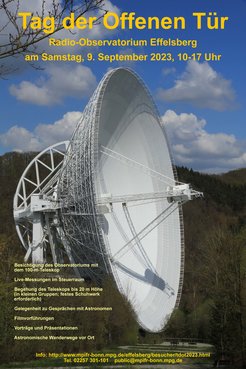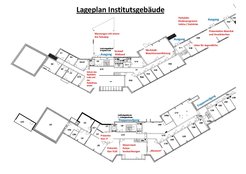Open Day at Effelsberg Radio Observatory
on Saturday, September 09, 2023
The Effelsberg Radio Observatory, home of the giant 100-m Radio Telescope of the Max Planck Institute for Radio Astronomy (MPIfR), will celebrate its next Open Day on Saturday, September 09, 2023, between 10 am and 5 pm. The Open Day provides an excellent opportunity to see the radio observatory from inside and even access the first platform of the 100-m telescope 20 metres above ground.

The Effelsberg Radio Telescope is in full operation for more than 50 years now and still the largest fully steerable radio telescope in Europe. Protected against radio frequency interference (RFI), it is based in a valley near Bad Münstereifel-Effelsberg, about 40 kilometres southwest of Bonn. The observatory also hosts a station of the International LOFAR Telescope, a European network for radio observations at metre wavelengths.
At the Open Day everyone is welcome to visit the observatory, see the control room where the observations are supervised and also have a close view onto the 100-m Radio Telescope.
When accessing the elevation platform at a height of 20 meters, it should be noted that this requires sturdy shoes, as well as a good state of health and no fear of heights. This part of the program is not suitable for small children.
There is no entrance fee and no registration required for the Open Day.
When: Saturday, September 09, 2023, 10 am to 5 pm
Where: Effelsberg Radio Observatory, Max-Planck-Straße, 53902 Bad Münstereifel (please follow the guidance in the two small villages Lethert and/or Effelsberg)
What: Open Day at Effelsberg Radio Observatory
Open Day Poster: TDOT2023 (PDF file, 0.5 MB, in German)
The site of the radio observatory in the valley of the Effelsberg creek (“Effelsberger Bach”) will be accessible via a footpath from the parking lot. A shuttle bus will be provided for people with physical disabilities.

********************************
There will be a series of presentations in the Radio Observatory building that day. Pulsar observations will take place in the control room on Saturday. Next door the principle of VLBI measurements will be explained, which are simultaneous observations within a worldwide network of radio telescopes.
Scientists will inform about the protection of the night sky, which is important not only for observations in visible light, but also for the study of the radio sky (keyword: frequency protection & radio frequency interference, RFI).
In the receiver laboratory, a receiver at 13 cm wavelength built by the Institute for the MeerKAT radio telescope in South Africa is on display; young people can also practice soldering there under supervision. A number of machines will be demonstrated in the workshop.
In the parking lot in front of the observatory building there will be a program for children and young people. There will also be a snack bar with food and drinks.
On the way to the second radio telescope on site, the Effelsberg station of the European low-frequency telescope LOFAR, information will be provided about the principle of this Europe-wide radio telescope network connected via fast data lines.
And as a highlight, there is the opportunity to enter the large 100-m telescope itself. There will be guided tours in small groups up to the so-called elevation stage of the telescope at a height of 20 m above ground.

********************************
Talks in the Lecture Theater (in German language):
10:45 Uhr Dr. Rainer Beck: Was Radiowellen über das Universum verraten
11:30 Uhr Dr. Thomas Krichbaum: Millionen-facher Zoom ins Herz von Galaxien
12:15 Uhr Jessica Koch: : Eine Reise durch das Sonnensystem (Kindervortrag)
13:30 Uhr Dr. Helmut Wiesemeyer: Das Schicksal der Sonne - oder: Über das Altern der Sterne
14:15 Uhr Dr. Laura Spitler: Pulsare und schnelle Radioblitze: der lebhafte Himmel
15:00 Uhr Dr. Gyula Josza / Dr. Benjamin Winkel: Satelliten, Handys, Beleuchtung: Geht uns der Himmel verloren?
15:45 Uhr Dr. Nadya Ben Bekhti: Ich sehe was, was Du nicht siehst – Galaxien
bei verschiedenen Wellenlängen
Talks of approx. 25 minutes
********************************


